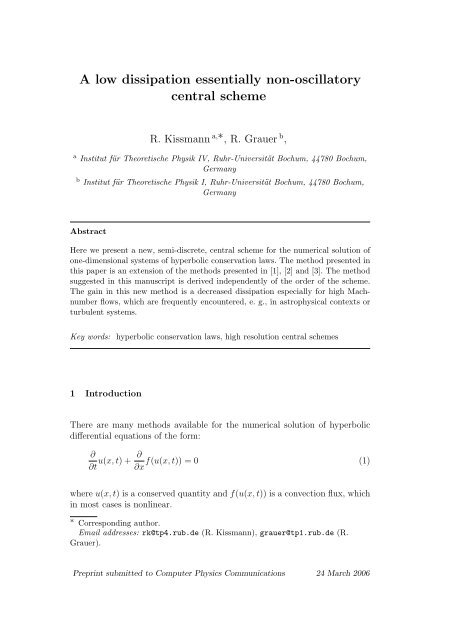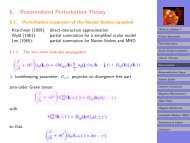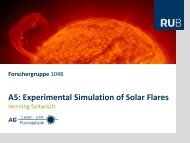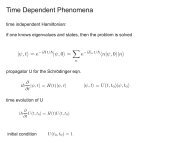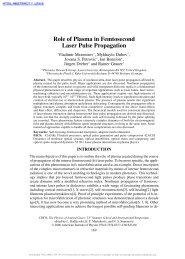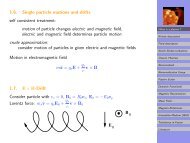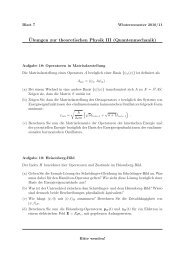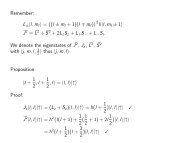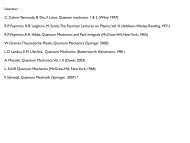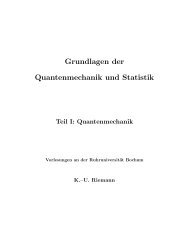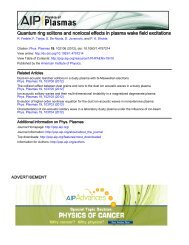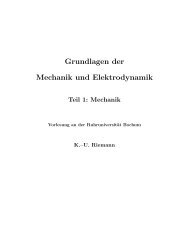Download (pdf 0.3MB) - Institut für Theoretische Physik I - Ruhr ...
Download (pdf 0.3MB) - Institut für Theoretische Physik I - Ruhr ...
Download (pdf 0.3MB) - Institut für Theoretische Physik I - Ruhr ...
You also want an ePaper? Increase the reach of your titles
YUMPU automatically turns print PDFs into web optimized ePapers that Google loves.
A low dissipation essentially non-oscillatory<br />
central scheme<br />
R. Kissmann a,∗ , R. Grauer b ,<br />
a <strong>Institut</strong> für <strong>Theoretische</strong> <strong>Physik</strong> IV, <strong>Ruhr</strong>-Universität Bochum, 44780 Bochum,<br />
Germany<br />
b <strong>Institut</strong> für <strong>Theoretische</strong> <strong>Physik</strong> I, <strong>Ruhr</strong>-Universität Bochum, 44780 Bochum,<br />
Germany<br />
Abstract<br />
Here we present a new, semi-discrete, central scheme for the numerical solution of<br />
one-dimensional systems of hyperbolic conservation laws. The method presented in<br />
this paper is an extension of the methods presented in [1], [2] and [3]. The method<br />
suggested in this manuscript is derived independently of the order of the scheme.<br />
The gain in this new method is a decreased dissipation especially for high Machnumber<br />
flows, which are frequently encountered, e. g., in astrophysical contexts or<br />
turbulent systems.<br />
Key words: hyperbolic conservation laws, high resolution central schemes<br />
1 Introduction<br />
There are many methods available for the numerical solution of hyperbolic<br />
differential equations of the form:<br />
∂ ∂<br />
u(x, t) + f(u(x, t)) = 0 (1)<br />
∂t ∂x<br />
where u(x, t) is a conserved quantity and f(u(x, t)) is a convection flux, which<br />
in most cases is nonlinear.<br />
∗ Corresponding author.<br />
Email addresses: rk@tp4.rub.de (R. Kissmann), grauer@tp1.rub.de (R.<br />
Grauer).<br />
Preprint submitted to Computer Physics Communications 24 March 2006
Of all the schemes available for the solution of such an equation the central<br />
schemes offer the advantage of simplicity as compared for example to upwinding<br />
schemes (see e. g. in [4] or [5]). The first central scheme – the well-known<br />
Lax-Friedrichs scheme (see [6]), however, readily shows the most prominent<br />
problem of central schemes: They suffer from high numerical dissipation as<br />
compared to other (more complex) schemes. This issue was attacked by increasing<br />
the order of the scheme (see [7] for the first second order extension<br />
of the scheme and [8] for a third order version of the scheme). Dissipation for<br />
small timesteps was reduced by the introduction of the semidiscrete version of<br />
these schemes (see [1] for the semidiscrete version of the second order scheme<br />
and [2] for the third order semidiscrete scheme) For high Mach-number flows,<br />
however, the dissipation becomes more and more dominant, due to the estimate<br />
for the Riemann fans getting worse. This could markedly be improved<br />
with a better estimate for the Riemann-fans (see [3]). Even then, however,<br />
the width of the Riemann fans still scales directly with the Mach number for<br />
high Mach number flows, thus, yielding poor results for the latter. Therefore,<br />
we followed the path taken by [3] even further, arriving at a scheme with significantly<br />
reduced dissipation where the Riemann fans do not depend on the<br />
Mach number of the flow. Especially for high Mach-number flows this scheme,<br />
described in this manuscript, delivers very encouraging results as is demonstrated<br />
with some examples. This feature is valuable for many applications of<br />
numerical schemes to e. g. high Mach-number astrophysical flows.<br />
2 The classical Cweno scheme<br />
Before introducing the ideas of the new scheme we will briefly describe the<br />
Cweno scheme as presented in former publications. For a more detailed introduction<br />
see [1], [2] and references therein.<br />
The basic idea for the classical central schemes is an integration of Eq. (1) over<br />
one small cell of width ∆x and a small timestep ∆t. Such an integration leads<br />
to a description of the evolution of the cell average of the quantity u(x, t). For<br />
this one also needs a piecewise polynomial reconstruction, which regains pointvalues<br />
from the cell averages – yielding different functions for each individual<br />
cell. For a first-order piecewise linear reconstruction one obtains the Lax-<br />
Friedrichs scheme given on a staggered grid. The idea behind this is that we<br />
have to integrate over the domain containing the Riemann fan, which evolves<br />
from the discontinuity due to the different reconstructions in adjacent cells.<br />
As a result we do not have to compute the exact evolution of the Riemann<br />
fan and, thus, obtain a very handy scheme.<br />
In contrast to the Lax-Friedrichs scheme the Cweno scheme is not requiring<br />
an integration over the whole volume of each cell. Instead Eq. (1) is integrated<br />
2
over the volume containing the Riemann fans and over the undisturbed volume<br />
separately. By this, the dissipation can be significantly diminished, since only<br />
for the region containing the Riemann fan an averaging is done. The integration<br />
over these sub-volumes and one timestep yields an evolution equation for<br />
the cell averages of the sub-volumes. By a projection of these onto the original<br />
grid and the transition ∆t → 0 one finally arrives at a semi-discrete evolution<br />
scheme for the cell averages, which does not require a staggered grid anymore.<br />
Additionally the semi-discrete scheme does not suffer from the accumulation<br />
of excessive dissipation for small timesteps as a fully discrete scheme would<br />
do.<br />
3 The new scheme<br />
The Cweno scheme described briefly in the preceding section is robust, essentially<br />
non-oscillatory, one whose main feature is its simplicity. In consecutive<br />
publications its inventors suggested less and less dissipative schemes. Part of<br />
this goal was achieved by increasing the order of the piecewise reconstruction<br />
of point values from the cell averages (see, e. g. [2] for the step from second<br />
to third order).<br />
A major part of the dissipation inherent in the Cweno scheme is, however,<br />
connected to the width of the regions assumed to contain the Riemann fans.<br />
The dissipation was markedly reduced again, when the estimate for the extent<br />
of the Riemann fans was refined in [3]. In this publication the authors distinguished<br />
the possible propagation speed of the Riemann fans to the left and to<br />
the right. If, e. g., the velocity of a fluid to be computed exactly equals the<br />
maximum propagation speed of any signal in the fluid a shock can not propagate<br />
upstream, and the region over which the averaging for the Riemann fans<br />
is done extends only into one cell. In the case, where the distinction of the<br />
propagation direction is not made the averaging region extends symmetrically<br />
into both cells under consideration. Thus, this region is twice as wide as for<br />
the refined scheme.<br />
If the scheme is, however, applied to high Mach number flows, the flow velocity<br />
on average exceeds the maximum propagation speed of signals in the fluid.<br />
Then the width of the regions over which the integration takes place is roughly<br />
given by the speed of the flow times the timestep (or rather twice that value<br />
if the directional distinction is not made). The actual width of the region<br />
where the shock can possibly be is, however, only two times the maximum<br />
signal propagation speed times the timestep. Since this differs markedly from<br />
the assumption in the Cweno scheme, we felt that it might be interesting to<br />
pursue the approach from [3] a little further in search of a scheme with even<br />
less dissipation.<br />
3
Fig. 1. Typical Riemann fan structure for high Mach number flow.<br />
To motivate our new approach one can imagine a typical flow structure of a<br />
conservative system of equations as given in Fig. 1. What is depicted there is<br />
the case for a supersonic flow directed to the right. The cell under consideration<br />
with centre at x i has boundaries at x i−1/2 and x i+1/2 The two horizontal lines<br />
indicate two successive timesteps. The average flow velocity at the boundary<br />
of the cell at the first of these timesteps is indicated by the solid line as the<br />
position taken by a particle convected with that velocity. In the same way<br />
the maximum propagation speed of signals are indicated as the dashed lines<br />
– clearly we are discussing supersonic flow.<br />
The region in which the averaging over the Riemann fans is done in the<br />
Kurganov et al - version (see [3]) of the scheme is indicated as the filled<br />
rectangle on each boundary of the cell. The position of a possible discontinuity,<br />
which gives rise to the idea of the averaging, however, can only be found<br />
between the dashed lines. Therefore, we suggest an alternative derivation of<br />
the Cweno scheme, where the domains over which the integration takes place<br />
are not rectangular any more.<br />
Here we perform the averaging instead over the shaded parallelogram regions<br />
indicated in Fig. 1. The main difference is, that the position of the boundaries<br />
for the integral over the spatial domains now depend on time. The width of<br />
the Riemann fans, however, is given only by the maximum signal propagation<br />
velocity so that the background flow does not change the width of the fans –<br />
in contrast to the other schemes.<br />
For these regions one can derive a scheme very similar to the others when<br />
using exactly the same steps as were used for the established Cweno scheme:<br />
First we integrate the regions of smooth flow and the regions which might<br />
4
hold discontinuities separately. Then we obtain a new reconstruction for these<br />
regions and finally project all this back onto the desired spatial grid. The first<br />
step in this scheme is the integration of the different regions. This is done in<br />
the following section for the smooth and discontinuous regions separately.<br />
3.1 Integration of the discontinuities<br />
Since the averaging is to take place over a region inclined with the local average<br />
velocity we have to deal with smaller Riemann-fans than they are used in<br />
the established Cweno scheme for high Mach-number flows. Here the width<br />
of the Riemann fans is basically given by twice the maximum signal propagation<br />
velocity (possibly running to the left or to the right) – behold that this<br />
signal propagation is only possible relative to the average fluid velocity). In<br />
subsequent computations we will use the following conventions for the different<br />
velocities:<br />
vi−1/2 0 → local average velocity<br />
(2)<br />
a ± i−1/2 → right (left) maximum signal velocity relative to mean flow<br />
As mentioned already, the solution can only be discontinuous in the hatched<br />
parallelogram regions. Assuming the velocities are constant for a small time<br />
dt time the region is given by:<br />
[x n i−1/2,l , x n i−1/2,r] = (3)<br />
[<br />
xi−1/2 − a − i−1/2 ∆t + v0 i−1/2(t − t n ) , x i−1/2 + a + i−1/2 ∆t + v0 i−1/2(t − t n ) ]<br />
So we see that the region is shifted to the right with the corresponding average<br />
velocity. For the integration over this particular region and the time interval<br />
[t n , t n+1 ] one has to keep in mind, that we have to do the spatial integration<br />
first due to the dependence of its boundaries on time. Integration of Eq. (1)<br />
over space and time then yields:<br />
∫<br />
t n+1<br />
t n<br />
⎛<br />
⎞<br />
x i−1/2,r (t)<br />
∫<br />
∫<br />
⎜ ∂<br />
⎝<br />
∂t u dx ⎟<br />
⎠ dt = −<br />
x i−1/2,l (t)<br />
t n<br />
t n+1<br />
⎛<br />
⎜<br />
⎝<br />
x i−1/2,r (t)<br />
∫<br />
x i−1/2,l (t)<br />
⎞<br />
∂f<br />
∂x dx ⎟<br />
⎠ dt (4)<br />
To evaluate the left-hand side of this equation we have to use:<br />
d<br />
dt<br />
b(t) ∫<br />
a(t)<br />
g(x, t)dx = db da<br />
g(b, t) −<br />
dt<br />
∫b(t)<br />
dt g(a, t) +<br />
a(t)<br />
∂<br />
g(x, t)dx (5)<br />
∂t<br />
5
For our case this translates into:<br />
∫<br />
t n+1<br />
t n<br />
=<br />
=<br />
⎛<br />
⎜<br />
⎝<br />
x i−1/2,r (t)<br />
∫<br />
x i−1/2,l (t)<br />
⎛<br />
t∫<br />
n+1 x i−1/2,r (t)<br />
∫<br />
⎜<br />
t n<br />
−<br />
⎝ d dt<br />
x i−1/2,l (t)<br />
⎞<br />
∂<br />
∂t u dx ⎟<br />
⎠ dt<br />
⎞<br />
⎟<br />
u(x, t) dx⎠ dt<br />
t∫<br />
n+1 ( d<br />
dt x i− 1 ,ru(x i− 1 ,r, t) − d )<br />
2 2 dt x i− 1 ,lu(x i− 1 ,l, t) 2 2<br />
t n<br />
x i−1/2,r (t n+1 )<br />
∫<br />
x i−1/2,l (t n+1 )<br />
−<br />
t∫<br />
n+1<br />
u(x, t n+1 ) dx −<br />
x i−1/2,r (t n )<br />
∫<br />
x i−1/2,l (t n )<br />
t n (<br />
v<br />
0<br />
i−1/2<br />
[<br />
u(xi− 1<br />
2 ,r, t) − u(x i− 1 2 ,l, t)]) dt<br />
dt<br />
u(x, t n ) (6)<br />
due to the dependence of the domains on time. Here the terms containing v 0 i−1/2<br />
are introduced due to the time dependence of the cell boundary positions.<br />
Then we find using Eqns. (6) and (4) (and designating the average for this<br />
region at time t n+1 as ¯ω n+1<br />
i−1/2 ):<br />
∫<br />
t n+1<br />
t n<br />
⎛<br />
⎜<br />
⎝<br />
x i−1/2,r (t)<br />
∫<br />
x i−1/2,l (t)<br />
⎞<br />
∂<br />
∂t u dx ⎟<br />
⎠ dt (7)<br />
x i−1/2,r (t n )<br />
∫<br />
= (x i−1/2,r (t n+1 ) − x i−1/2,l (t n+1 ))¯ω n+1<br />
i−1/2 − u dx<br />
−<br />
t∫<br />
n+1<br />
( [<br />
v<br />
0<br />
i−1/2 u(xi−1/2,r (t)) − u(x i−1/2,l (t)) ])<br />
t n ⎛<br />
⎞<br />
t∫<br />
n+1 x i−1/2,r (t)<br />
∫<br />
⎜ ∂f<br />
= − ⎝<br />
∂x dx ⎟<br />
⎠ dt<br />
t n<br />
x i−1/2,l (t)<br />
x i−1/2,l (t n )<br />
Here the boundaries of the region are given by:<br />
x i−1/2,l (t) = x i−1/2 − a − i−1/2 ∆t + v0 i−1/2(t − t n )<br />
x i−1/2,r (t) = x i−1/2 + a + i−1/2 ∆t + v0 i−1/2(t − t n ) (8)<br />
6
as was given in Eq. (3) With this in mind we also perform the flux integration,<br />
thus arriving at an intermediate result for the local average at the next<br />
timestep t n+1 :<br />
( x i−1/2,r (t n )<br />
∫<br />
¯ω n+1<br />
i−1/2 = 1<br />
u dx<br />
x i−1/2,r (t n+1 ) − x i−1/2,l (t n+1 )<br />
x i−1/2,l (t n )<br />
=<br />
+<br />
−<br />
∫<br />
t n+1<br />
t n<br />
∫<br />
t n+1<br />
t n<br />
(<br />
v<br />
0<br />
i−1/2<br />
(<br />
u(xi−1/2,r (t)) − u(x i−1/2,l (t)) )) dt<br />
(<br />
f(u(xi−1/2,r , t)) − f(u(x i−1/2,l , t)) ) dt<br />
1<br />
( x i−1/2<br />
∫<br />
x i−1/2,r (t n+1 ) − x i−1/2,l (t n+1 )<br />
−<br />
+<br />
∫<br />
t n+1<br />
t n<br />
∫<br />
t n+1<br />
t n<br />
x i−1/2,l (t n )<br />
p n i−1 dx +<br />
(<br />
f(u(xi−1/2,r , t)) − v 0 i−1/2u(x i−1/2,r (t)) ) dt<br />
(<br />
f(u(xi−1/2,l , t)) − v 0 i−1/2u(x i−1/2,l (t)) ) dt<br />
)<br />
x i−1/2,r (t n )<br />
∫<br />
x i−1/2<br />
p n i dx<br />
Here we introduced the representation of the quantity u by a polynomial p n i<br />
given for each individual cell. For the region under consideration we have<br />
to deal with two different polynomials, since we are considering a domain<br />
extending into two neighbouring cells.<br />
Apart from the additional flux-terms vi−1/2 0 u(x i−1/2,i(t)) this result looks familiar<br />
when consulting the previous publications (see e. g. [3]). The interpretation,<br />
however, is quite different: On the one hand the cell average ¯ω n+1<br />
i−1/2<br />
is not given<br />
at the same location as ¯ω<br />
i−1/2 n . On the other hand one has to evaluate the flux<br />
integral for time-dependent boundaries.<br />
Keeping this in mind the integral for the central part of the cell can be computed<br />
in the same way resulting in the expression:<br />
)<br />
(9)<br />
( x i+1/2,l (t n )<br />
∫<br />
¯ω i n+1<br />
1<br />
=<br />
p n<br />
x i+1/2,l (t n+1 ) − x i−1/2,r (t n+1 i dx +<br />
)<br />
x i−1/2,r (t n )<br />
−<br />
∫<br />
t n+1<br />
t n<br />
(<br />
f(u(xi+1/2,l , t)) − v 0 i+1/2u(x i+1/2,l (t)) ) dt<br />
7
∫<br />
+<br />
t n+1<br />
t n<br />
(<br />
f(u(xi−1/2,r , t)) − v 0 i−1/2u(x i−1/2,r (t)) ) dt<br />
)<br />
(10)<br />
We note the following:<br />
• Considering the above equation for an exclusive transport case motivates<br />
the validity of the formula. If for example only the velocities at the upper<br />
and lower cell boundary differ, with the flux in the cell being constant, then<br />
the dominant effect is the increase or decrease of the cell average ¯ω due to<br />
the different size of the cell at times t n and t n+1 .<br />
• The velocity suggested to be chosen for vi±1/2 0 is the local average velocity<br />
as was mentioned above. It is, however, also possible to use a more global<br />
choice. For example for a global background flow velocity would also be an<br />
appropriate choice for this. This would then keep the cell sizes constant and<br />
yield a less dissipation scheme at the same time.<br />
• In the limit of high Mach numbers the velocities a ± i−1/2<br />
can be directly given<br />
as the maximum signal propagation velocity. Otherwise there usually is a<br />
different local velocity obtained from the reconstruction in adjacent cells.<br />
This has to be taken into account, by adding the maximum difference from<br />
the average velocity to the maximum signal propagation velocity.<br />
The next step in the classic Cweno scheme would be the projection back onto<br />
the original grid. This would in our case, however, be much more involved due<br />
to the shift of the cells at the next time step. Apart from that some simplifying<br />
assumption as were used in the old scheme cannot be used any longer. For<br />
example the conservation property of the reconstruction for the central part<br />
of the cell is of no use whenever this region has to be projected onto more<br />
than one of the cells (i. e. whenever v 0 i+1/2 > a− i+1/2 or v0 i−1/2 < −a+ i−1/2 )<br />
While such a projection is still possible in our case, we will follow a different<br />
strategy to retain the simplicity of the Cweno scheme (which would be lost<br />
in the case of the classical projection).<br />
First we project the values not onto the actual grid, but onto the transported<br />
grid, thus, obtaining cell averages for a not necessarily homogeneous grid.<br />
The cell averages can then be projected back onto the original grid whenever<br />
necessary. For this one would use an additional reconstruction step, where the<br />
full order of the reconstruction has to be used to keep the desired order of the<br />
scheme.<br />
The width and position of the grid cells at the next timestep becomes clear<br />
from Fig. 1 and from Eq. (3). With the local transport velocity v 0 this reads:<br />
I n+1<br />
i = [x n+1<br />
i+1/2 − xn+1 i−1/2 ] = [(xn i+1/2 + v 0 i+1/2∆t) − (x n i−1/2 + v 0 i−1/2∆t)] (11)<br />
8
To be able to project the local cell averages onto this grid we use a polynomial<br />
reconstruction for timestep t n+1 : We construct a new non-oscillatory global<br />
piecewise interpolant from the local cell averages at time t n+1 as:<br />
˜ω n+1 (x) = ∑ i<br />
(<br />
)<br />
˜ω n+1<br />
i−1/2 (x)χ [x n+1<br />
i−1/2,l ...xn+1 i−1/2,r ] + ˜ωn+1 i (x)χ [x<br />
n+1<br />
i−1/2,r ...xn+1 i+1/2,l ] (12)<br />
From this we obtain the cell averages on the shifted grid by:<br />
ū n+1<br />
i = 1<br />
˜∆x<br />
x n+1<br />
i+1/2<br />
∫<br />
x n+1<br />
i−1/2<br />
˜ω n+1 (x) dx (13)<br />
where ˜∆x is the width of the shifted cell Ii<br />
n+1 . Since we are interested in<br />
the semi-discrete version of the scheme we proceed by expressing the time<br />
derivative by:<br />
d<br />
dtūi(t) = lim<br />
∆t→0<br />
ū n+1<br />
i<br />
− ū n i<br />
∆t<br />
⎜<br />
∆t→0 ⎝<br />
= lim<br />
⎛<br />
1<br />
˜∆x<br />
x n+1<br />
i+1/2<br />
∫<br />
x n+1<br />
i−1/2<br />
˜ω n+1 (x) dx − ū n i<br />
⎞<br />
⎟<br />
⎠ (14)<br />
where one has to keep in mind, that u n+1 is given at another position on the<br />
spatial grid than u n .<br />
For this we need to evaluate the integrals over the smooth and non-smooth<br />
parts of the shifted cells. Due to the conservation property of the reconstruction<br />
for the smooth part of the cell (in the shifted frame) we have:<br />
1<br />
x i+1/2,l (t n+1 ) − x i−1/2,r (t n+1 )<br />
x i+1/2,l (t n+1 )<br />
∫<br />
x i−1/2,r (t n+1 )<br />
˜ω n+1<br />
i (x) dx = ū n+1<br />
i (x) (15)<br />
Apart from that for the non-smooth parts of the cell the limited width of the<br />
Riemann-fans in the limit dt → 0 leads to the result:<br />
˜ω n+1<br />
i±1/2<br />
(x) = ¯ωn+1<br />
i±1/2<br />
(x) + O(∆t) (16)<br />
Thus, we find in the semi-discrete limit (dt → 0):<br />
(<br />
d<br />
1 Li ∩ Ii<br />
n+1<br />
dtūi(t) = lim<br />
∆t→0 ∆t ˜∆x<br />
¯ω n+1<br />
i−1/2 + Cn+1 i<br />
˜∆x<br />
¯ωn+1 i (17)<br />
9
+ R i ∩ Ii<br />
n+1<br />
˜∆x<br />
¯ω n+1<br />
i+1/2 − ūn i<br />
)<br />
where I n+1 indicates the shifted cell at t n+1 . The individual domains needed<br />
here are given in the semi-discrete limit as:<br />
L i ∩ I n+1<br />
i = x i−1/2,r (t n+1 ) − x i−1/2 (t n+1 ) = a + i−1/2<br />
(18)<br />
Ci n+1 = x i+1/2,l (t n+1 ) − x i−1/2,r (t n+1 ) (19)<br />
R i ∩ Ii n+1 = x i+1/2 (t n+1 ) − x i+1/2,l (t n+1 ) = a − i+1/2<br />
(20)<br />
What is still missing are the cell averages for the smooth and non-smooth<br />
regions. Beginning with the latter of those (here we have to keep in mind that<br />
we have R i−1 = L i ) we find by usage of Eq. (9):<br />
lim<br />
∆t→0 ¯ωn+1 i−1/2 = a− i−1/2 u− i−1/2 + a+ i−1/2 u+ i−1/2<br />
(a + i−1/2 + a− i−1/2 ) − (f(u+ i−1/2 ) − v0 i−1/2 u+ i−1/2 )<br />
(a + i−1/2 + a− i−1/2 )<br />
+ (f(u− i−1/2 ) − v0 i−1/2 u− i−1/2 )<br />
(a + i−1/2 + a− i−1/2 ) (21)<br />
The computation for the central part is a little more involved and can be<br />
shown to yield:<br />
lim<br />
∆t→0 ¯ωn+1 i = ūn i ∆x − (a + i−1/2 u+ i−1/2 + a− i+1/2 u− i+1/2 )∆t<br />
(x i+1/2,l (t n+1 ) − x i−1/2,r (t n+1 ))<br />
− (f(u− i+1/2 ) − v0 i+1/2 u− i+1/2 )<br />
(x i+1/2,l (t n+1 ) − x i−1/2,r (t n+1 )) ∆t<br />
+ (f(u+ i−1/2 ) − v0 i−1/2 u+ i−1/2 ))<br />
∆t (22)<br />
(x i+1/2,l (t n+1 ) − x i−1/2,r (t n+1 ))<br />
Both of these can be recast into:<br />
lim<br />
∆t→0 ¯ωn+1 i−1/2 = ã− i−1/2 u− i−1/2 + ã+ i−1/2 u+ i−1/2<br />
(a + i−1/2 + a− i−1/2 ) − (f(u+ i−1/2 ) − f(u− i−1/2 ))<br />
(a + i−1/2 + a− i−1/2 ) (23)<br />
lim<br />
∆t→0 ¯ωn+1 i = ūn i ∆x − (ã + i−1/2 u+ i−1/2 + ã− i+1/2 u− i+1/2 )∆t<br />
(x i+1/2,l (t n+1 ) − x i−1/2,r (t n+1 ))<br />
(f(u − i+1/2<br />
−<br />
) − f(u+ i−1/2 ))<br />
∆t (24)<br />
(x i+1/2,l (t n+1 ) − x i−1/2,r (t n+1 ))<br />
where we used the redefined velocities:<br />
ã + = a + + v 0 and ã − = a − − v 0 (25)<br />
10
for each of the positions in the numerical scheme.<br />
Consequently, we find:<br />
and:<br />
lim<br />
∆t→0<br />
( )<br />
1 C<br />
n+1<br />
−ã+<br />
i<br />
∆t ˜∆x ¯ωn+1 i − ū n i−1/2<br />
i = u+ i−1/2 + ã− i+1/2 u− i+1/2<br />
˜∆x<br />
− (f(u− i+1/2 ) − f(u+ i−1/2 ))<br />
˜∆x<br />
+ 1 ∆t<br />
( ∆x<br />
∆˜x − 1 )<br />
ū n i (26)<br />
( )<br />
1 ∆x<br />
∆t ∆˜x − 1 ū n i = ( vi+1/2 0 − vi−1/2) 0 ūn i (27)<br />
Inserting this, together with the results for the other terms obtained above,<br />
into Eq. (17) yields:<br />
d<br />
dtūi(t) = − H i+1/2 − H i−1/2<br />
+ ( vi+1/2 ˜∆x<br />
0 − vi−1/2) 0 ūn i (28)<br />
where we introduced:<br />
H i+1/2 = −ã+ i+1/2 a− i+1/2 u+ i+1/2 − a+ i+1/2ã− i+1/2 u− i+1/2<br />
a + i+1/2 + a− i+1/2<br />
+ a+ i+1/2 f(u− i+1/2 ) + a− i+1/2 f(u+ i+1/2 )<br />
a + i+1/2 + a− i+1/2<br />
(29)<br />
Obviously we found a result very similar to that for the classical Cweno<br />
scheme. The main differences are that we have to distinguish between the two<br />
different kinds of velocities and that the resulting changes are given for the<br />
shifted grid. Also the correction term ( v 0 i+1/2 − v0 i−1/2)<br />
ūn i has to be included.<br />
This term ensures change of the cell average, whenever the cell size is modified.<br />
We note:<br />
• The resulting evolution requires a moving, generally non-uniform grid. The<br />
cell averages at the next timestep are in general given at a shifted position.<br />
This usually poses no problems (for limits on this see section 5). The<br />
main limitation in a one-dimensional computation is that one has to take<br />
the varying sizes of the individual cells into account, when computing the<br />
reconstruction for the next timestep. Whenever an output on an equidistant<br />
grid is desired or the individual cells get too big or too small the results can<br />
be projected back to the original grid.<br />
11
• The shift of each individual cell is given by:<br />
δx i−1/2 =<br />
∫t 1<br />
t 0 v 0 i−1/2(t)dt (30)<br />
for the lower boundary of cell I i . From this the actual size of the corresponding<br />
cell is easily computed.<br />
• Alternatively the projection back onto the equidistant grid can be done<br />
after each successfully completed timestep. Such a scheme would, however,<br />
become more complicated.<br />
• The velocity v 0 at the boundary of the individual cell does not have to be<br />
the local average - one could also use a global average instead. This does<br />
not change the above results at all.<br />
This concludes the derivation and description of the scheme. To motivate the<br />
usefulness of the scheme we will now discuss a few illustrative test-cases.<br />
4 Test problems<br />
Since the scheme developed in this manuscript is a strict one dimensional<br />
scheme, we only discuss a few one dimensional tests. Despite the fact that<br />
linear transport is solved exactly by this scheme we will nonetheless start our<br />
discussion by this to show its power.<br />
4.1 Linear transport<br />
For a strictly linear transport problem, which is quite often employed to determine<br />
the order of a numerical scheme the scheme presented in this manuscript<br />
is naturally dissipation free. This is due to the fact that the flux for linear<br />
transport is equivalent to the global mass flux ṽu in Eq. (29). Therefore, all<br />
the terms cancel for all individual cells, thus, leaving all cell averages unchanged.<br />
The only change resulting in linear transport is the transport of the<br />
cell boundaries all with the same velocity. This means that the initial profile is<br />
just transported along with the desired velocity as is to be expected in linear<br />
transport.<br />
The result of such a computation is shown in Fig. 2 where the result of a<br />
box like density enhancement is shown at t = 1 where the initial profile was<br />
transported from x = 0.5 to x = 1.5 with the velocity v 0 = 1.0. Despite the<br />
fact, that only sixteen cells were used in this computation there was clearly<br />
no dissipation as could be expected from the scheme.<br />
12
Fig. 2. Linear transport of a box like density enhancement. Comparison of initial<br />
(left) to resulting (right) profile.<br />
The next test was a little more involved. As a result it showed the strength<br />
and at the same time the weakness of the scheme, leading to the conclusion,<br />
that the scheme is especially suited for high Mach number flows.<br />
4.2 Strong shock tube<br />
The second test is a modification of the shock tube problem first used by Sod<br />
[9]. Here we used the strong shock tube problem (see [10]) with the initial<br />
condition:<br />
⎧<br />
⎪⎨ [10, 100] if x < 0.5<br />
[ρ(x), p(x)] =<br />
(31)<br />
⎪⎩ [1, 1] if x ≥ 0.5<br />
In this test the resulting gradients are even stronger than in the classical shock<br />
tube problem. The above was used as the initial condition for the 1-D Euler<br />
system:<br />
∂<br />
ρ = − ∂ s<br />
∂ t ∂ x<br />
(32)<br />
∂<br />
s = − ∂ (<br />
s 2 /ρ + p ) ∂ t ∂ x<br />
(33)<br />
∂<br />
e = − ∂ ((e + p) s/ρ)<br />
∂ t ∂ x<br />
(34)<br />
where ρ is the mass density, s is the mass flux s = ρu and e is the energy<br />
density. This system was solved for 0 ≤ x ≤ 1 at t = 0 and integrated up to<br />
t = 0.08. At this time a strong rare-faction wave, a contact discontinuity and a<br />
13
Fig. 3. Solution of the strong shock tube problem at time t = 0.08 for v 0 = 0 (left)<br />
and v 0 = 20 (right) for the classical Cweno scheme. Additionally the exact solution<br />
is given as the thin solid line.<br />
strong shock (from left to right in the corresponding figures) have developed.<br />
The system was solved subject to a background flow of varying velocity.<br />
In Fig. 3 we show a comparison of the solutions obtained for no background<br />
flow and for a background flow with v 0 = 20 to the exact solution. Clearly, this<br />
background flow can be eliminated by a Galilei-transformation. This however<br />
is not possible in the general case. Here we use this constant background<br />
velocity field to compare it to the analytical solution.<br />
The given solutions were obtained with the classical Cweno scheme with<br />
a second order reconstruction. The solution without background flow (left)<br />
shows the ability of the scheme to nicely reproduce discontinuities. The solution<br />
on the right, however, clearly shows the dependence of the solution on<br />
the speed of the background flow. Clearly the solution in the right part of<br />
the domain is poorly resolved: The density in the region between the contact<br />
discontinuity and the shock never gets near the exact value anymore.<br />
The reason for the solution on the left hand side of the contact discontinuity<br />
to be better than on the right hand side is given by the arguments in the<br />
introductory discussion: The Mach number for the background flow is much<br />
higher on the right side of the discontinuity than on the left, which is due<br />
to the higher sound speed on the left as compared to the right side (the<br />
initial conditions imply c s = 3.74 to the left of the contact discontinuity and<br />
c S = 1.18 to the right. This clearly confirms the weakness of the Cweno<br />
scheme in handling high Mach number flows.<br />
For the new scheme we used the identical second order reconstruction as for the<br />
classical Cweno scheme. The results for the new scheme are finally illustrated<br />
in Fig. 4 in the same way as we gave the results for the old scheme. With the<br />
14
Fig. 4. Solution of the strong shock tube problems at time t = 0.08 for v 0 = 0 (left)<br />
and v 0 = 20 (right) for the new scheme. Additionally the exact solution is given as<br />
the thin solid line.<br />
crosses indicating the position of the cell centres the propagation of the cells<br />
becomes clearly visible. In this computation we did never project the data<br />
back onto the original grid. This leads to the depletion of grid-points in the<br />
region left of the contact discontinuity. Due to this depletion the result for<br />
that region is inferior to the low Mach number computation using the classical<br />
Cweno scheme. In the region right of the contact discontinuity, however, the<br />
grid-points are piled up leading to superior results in that region.<br />
Yet the most important result visible in Fig. 4 is the expected fact, that<br />
the solution is completely independent of the background flow: The solution<br />
does not change at all, when the velocity of the background flow is changed.<br />
Therefore, we were able to confirm that the numerical dissipation for this<br />
scheme is entirely independent of the Mach number of any background flow.<br />
Above all, it is also evident, that the results for high Mach number flows are<br />
much better using the new scheme. Especially in the region to the right of the<br />
contact discontinuity the solution for the classical Cweno scheme becomes<br />
poor for high Mach number flows. The new scheme, however yields consistently<br />
very accurate solutions for this region.<br />
5 Restrictions<br />
For the above test cases the solutions were computed solely on the co-moving<br />
grid without ever projecting it back to the original grid. This was done to<br />
keep the seem as simple as the classical Cweno scheme. As became apparent<br />
in the second test-case, however, gradients of the velocity cause a depletion<br />
of grid-points in some regions and an accumulation of grid-points in other<br />
15
egions. This leads to in inferior results, where grid-points are depleted and in<br />
superior results in regions with more grid-points.<br />
A higher density of grid-points, however, also affects the Courant number,<br />
since this contains the inverse of the cell width. This effect is partly compensated<br />
by the fact, that the local average velocity is not included in the Courant<br />
number anymore.<br />
Both these problems can be addressed by a modification of the scheme, where<br />
the computation is done on the regular grid. In this case, however, the resulting<br />
scheme becomes more complex than the classical Cweno scheme. Therefore,<br />
this matter is not discussed in this paper any further and will be left for future<br />
publications.<br />
One additional point to make is that due to the two problems mentioned<br />
above the scheme is not as easily applicable to all hyperbolic problems as<br />
was the classical Cweno scheme. When all the computations are done on<br />
the co-moving grid, e. g. Burgers equation can not be adequately solved by<br />
the scheme. This is due to the fact, that all grid points are advected into the<br />
discontinuities and cover an infinitely small region. This, also, would pose no<br />
problem anymore for a scheme done only on a regular grid.<br />
6 Conclusion<br />
Here we presented an improvement of the Cweno scheme, which proved very<br />
reliable in resolving discontinuities resulting from the solution of conservative<br />
systems of differential equations. The improvement is a more precise estimate<br />
of the Riemann fans in the derivation of the scheme. We were able to show<br />
how this lead to a scheme, which is entirely independent of any background<br />
flow. Therefore, this scheme is especially suited for the computation of high<br />
Mach number flows.<br />
Furthermore we were able to show, that the scheme computes linear transport<br />
entirely free of numerical dissipation. Also the results for discontinuities in the<br />
flow could be shown to be very accurate.<br />
The scheme proposed in this paper is as easily implemented as was the classical<br />
Cweno scheme before. The overall structure of the equations to be integrated<br />
numerically differs only marginally from those of the classical scheme, but the<br />
differences are quite strong as was shown above.<br />
The new scheme, when computed exclusively on the co-moving grid, combines<br />
features of a fully Lagrangian scheme with the ideas of the classical Cweno<br />
16
scheme. Unfortunately, however, it is not as versatile as the classical Cweno<br />
scheme. To obtain an equally versatile scheme one has to switch over from the<br />
fully Lagrangian picture to a semi-Lagrangian picture (see e. g. [11]). This,<br />
however, is left for future publications.<br />
Acknowledgements<br />
The authors would like to thank Dr. Horst Fichtner for valuable discussions<br />
on the manuscript.<br />
This work was partially financed by the Deutsche Forschungsgemeinschaft<br />
(DFG) through the Sonderforschungsbereich SFB 591.<br />
References<br />
[1] A. Kurganov, E. Tadmor, New high resolution central schemes for nonlinear<br />
conservation laws and convection-diffusion equations, JCP 160 (2000)<br />
241–282.<br />
[2] A. Kurganov, D. Levy, A Third-Order Semidiscrete Central Scheme for<br />
Conservation Laws and Convection-Diffusion Equations, SIAM J. Sci.<br />
Comput. 22 (2000) 1461–1488.<br />
[3] A. Kurganov, S. Noelle, G. Petrova, Semidiscrete Central-Upwind<br />
Schemes for Hyperbolic Conservation Laws and Hamilton–Jacobi Equations,<br />
SIAM J. Sci. Comput. 23 (3) (2001) 707–740.<br />
[4] E. F. Toro, Riemann Solvers and Numerical Methods for Fluid Dynamics,<br />
Springer-Verlag, 1997.<br />
[5] S. K. Godunov, Finite difference method for numerical computation of<br />
discontinuous solution of the equations of fluid dynamics, Mat. Sb. 47<br />
(1959) 271.<br />
[6] K. O. Friedrichs, P. D. Lax, Systems of conservation equations with a<br />
convex extension, Proc. Nat. Acad. Sci. 68 (1971) 1686–1688.<br />
[7] H. Nessyahu, E. Tadmor, Non-oscillatory central differencing for hyperbolic<br />
conservation laws, J. Comp. Phys.87 (1990) 408–463.<br />
[8] D. Levy, G. Puppo, G. Russo, Central WENO schemes for hyperbolic<br />
systems of conservation laws, Math. Model. Numer. Anal. 33 (1999) 547–<br />
571.<br />
[9] G. Sod, A survey of several finite difference methods for systems of nonlinear<br />
hyperbolic conservation laws, J. Comput. Phys. 27 (1978) 1–31.<br />
[10] A. C. Calder, B. Fryxell, T. Plewa, R. Rosner, L. J. Dursi, V. G. Weirs,<br />
T. Dupont, H. F. Robey, J. O. Kane, B. A. Remington, R. P. Drake,<br />
G. Dimonte, M. Zingale, F. X. Timmes, K. Olson, P. Ricker, P. MacNeice,<br />
17
H. M. Tufo, On Validating an Astrophysical Simulation Code, ApJS143<br />
(2002) 201–229.<br />
[11] A. Staniforth, J. Côté, Semi-Lagrangian Integration Schemes for Atmospheric<br />
Models – A Review, Monthly Weather Review 119 (1991) 2206–<br />
2223.<br />
18


